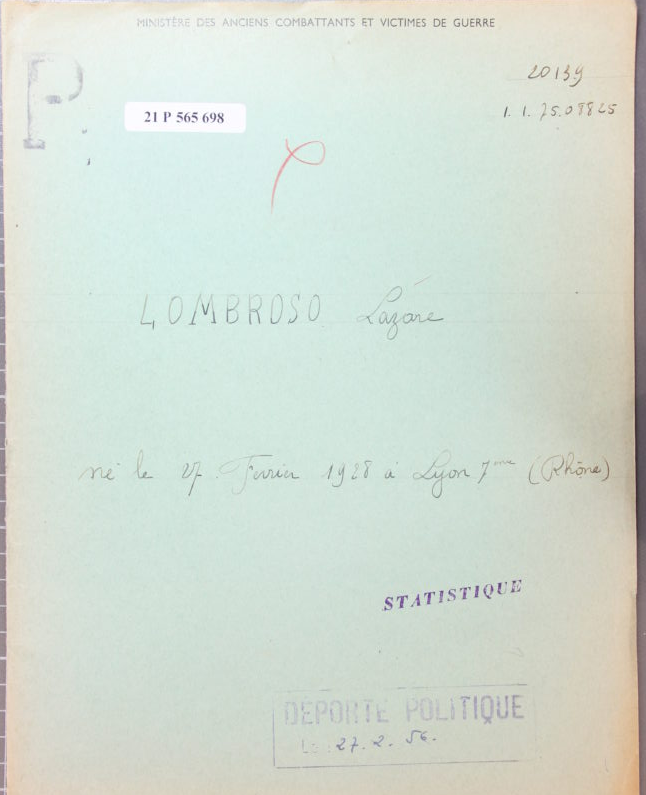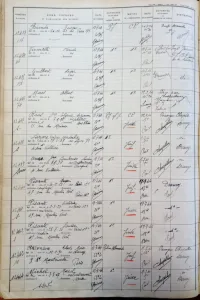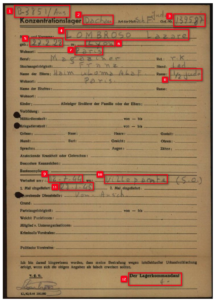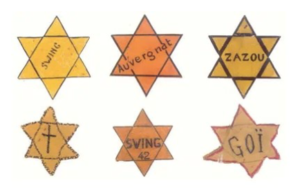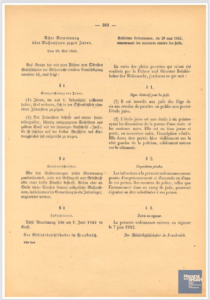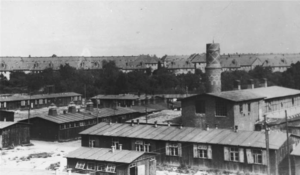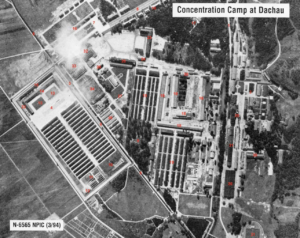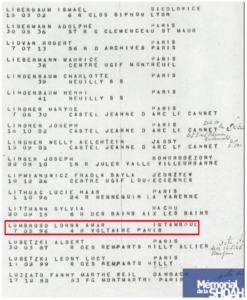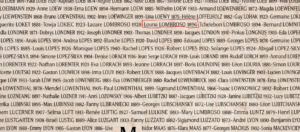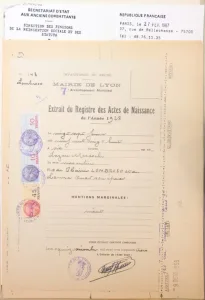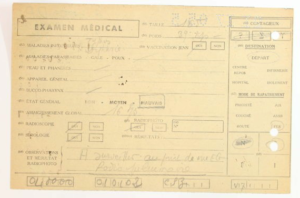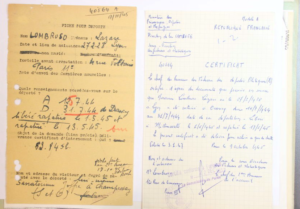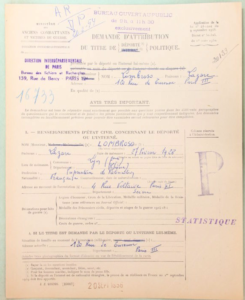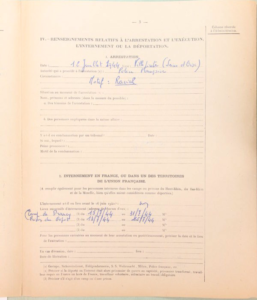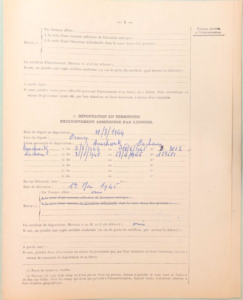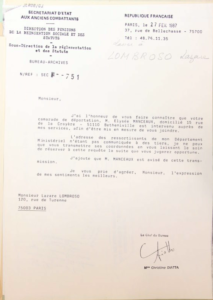Lazare LOMBROSO
Introduction
This is our attempt to reconstruct the life story of Lazare Lombroso, a Jewish boy who was deported during the Second World War, using the various sources that were available to us.
Date of birth:
Lazare was born at around 6am on February 27, 1928 in the 7th district of Lyon, in the Rhône department of France.
Family:
Lazare’s father was called Haïm Lombroso and his mother was Lonna or Louna. She was Jewish. A witness testimony also mentions that Lazare had a sister.
Childhood:
The family lived at 4 rue Voltaire in Paris. Lazare went to the elementary school for boys at 4, avenue de Bouvines in the 11th district of Paris.
Date of arrest:
July 12, 1944
After he was deported:
Lazare Lombroso returned to France and lived 120 rue de Turenne in the 3rd district of Paris, where we believe he also worked in a factory or for a magazine publisher.
He was made Knight of the French Legion of Honor in 2016. He died on September 28, 2019 in Fontenay-sous-Bois in the eastern suburbs of Paris.
Conclusion:
We have no further information about him, and from the records provided we were unable to find out any further details about his childhood or education.
Sources: DACCV (Victims of Contemporary Conflicts Archives Division of the Ministry of Defense Historical Service / The Arolsen Archives – International Center on Nazi Persecution
The arrest
The French police arrested Lazare Lombroso (on the grounds that the Nazis classified him as a “1/2 Jew”) in Villepinte, near Lyon, on July 12, 1944, following an anonymous tip-off. (source: deportesdelyon.fr).
We chose to show this record because it shows that Lombroso Lazare was arrested under the name of Lombroso Lonna.
Certificate from the Paris Police Headquarters
We decided to show this record since it lists the date and the place of his arrest.
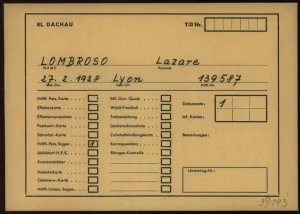
Source : ITS Bad Arolsen
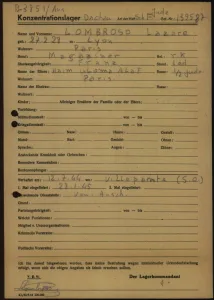
Source : ITS Bad Arolsen
The deportation
Lazare arrived at Drancy transit camp on July 15, 1944 and was assigned prisoner number 25187. The Drancy search log states that he had 24 francs on him at the time, which were confiscated from him. On July 31, 1944, he was transferred to KL Auschwitz (KL stands for KonzentrationsLager, which means concentration camp in German). He arrived there on August 3, 1944, and was registered as prisoner number B-3851. He was assigned to the job of “magazine worker”.
On January 28, 1945, he was hurriedly transferred to KL Dachau, where he arrived on February 4, 1945, having passed through KL Gross-Rosen. There he was assigned the number 139587. He was liberated on May 1, 1945 and began his journey back to France on May 13, where he arrived on May 17 in Sarrebourg, via the center of Strasbourg.
We produced a map of his journey using free mapping software.
The route taken by Lazare Lombroso when he was deported
Click here to see the map and the place names
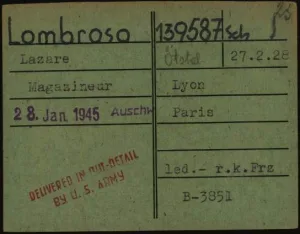
Auschwitz-Birkenau Museum Archives – Former prisoners department,
Ministry of Veterans and Victims of War
Source: deportesdelyon.fr
As regards the sudden transfer to KL Dachau on January 28, 1945, our research revealed the following information:
KL Auschwitz was liberated on January 27, 1945, but several records, including the KL Auschwitz and KL Dachau transfer lists, show that Lazare Lombroso was on a train that left on January 28, 1945. Several hypotheses are possible:
- The Russian advance on KL Auschwitz was slow, and it could have taken several days to liberate the camp.
- On or around January 12, 1945, when the Russian troops were only around 30 miles from KL Auschwitz, the Nazi authorities might have filled in the transfer lists before the prisoners were actually transported or sent on the death marches. This would mean that Lazare Lombroso could have been transferred to KL Dachau before January 28, 1945.
- the Red Army could have rewritten all the destroyed records to make it easier to count the remaining prisoners, and dated the lists January 28, 1945.
It should be borne in mind that in 1945, the administrative services in the camps were no longer very efficient, and that all important records, including prisoners’ individual files, were destroyed when the camps were liberated.
Key: 1. Auschwitz number; 2. Camp name; 3. Dachau; 4. identity; 5. Date of birth; 6. City of birth; 7. place of residence; 8. “race” (this is a Nazi document); 9. date of arrest; 10. place of arrest; 11. date of departure from Auschwitz; 12. camp commandant.
Lazare Lombroso’s testimony: arrest and deportation
“I wore the Star of David and had to put up with the various restrictions introduced by the anti-Semitic laws at that time, such as the ban on Jews in public places and the 8 p.m. curfew for all Jews.”
It became compulsory to wear the yellow star in the occupied part of France on May 29, 1942.
The Militärbefehlshaber in Frankreich or MbF, the German military command in France signed its 8th decree on May 29, making it compulsory for all Jews over the age of six in the occupied zone, whether French or foreign, to wear the “Jewish star” in public as of June 7, 1942.
“Jewish stars” during the Second World War
Examples of the laws about the wearing of the yellow star
“On July 12, 1944, the French police came to arrest me and my mother as a result of a tip-off. We were living in hiding with some friends in Villepinte. My sister, though, was in hiding someplace else. The police wanted to handcuff me, but my mother said that given that there was a written transcript of some oral witness statements that she was there, I wasn’t about to run away. I was handed over to the Gestapo and taken to prison. I was given the “bathtub treatment” to make me reveal the whereabouts of my sister.”
The bathtub torture involved plunging the prisoner into a tub of icy water, with his hands handcuffed behind his back, and holding his head underwater until he could hardly breath. If he still refused to talk, he was immediately pushed back into the water.
“We were then loaded into cattle cars and set off on a journey lasting three days and three nights, finally arriving at Auschwitz on August 3, 1944. During the initial journey to Paris, my mother had found it difficult to get down from the car, and as a result she was “beaten up” by the SS, and so was I, because I had tried to help her. We arrived, the selection was made: “Left: to the camp, right: to the crematorium”.
Photograph from the Auschwitz Album or Lili Jacob’s Album
“I was put in quarantine, then tattooed, and finally assigned to a block and an earthmoving kommando. There were all kinds of ‘trades’ in the camp, and some prisoners were lucky enough to work under cover.”
“At five in the morning, we had to get up with “ersatz” and then there was a roll call, which lasted for hours. In winter, we didn’t start work until daybreak, so the roll call lasted even longer. The work was carried out outside the camp. [We], the kommandos were assigned to a kapo (a long-standing inmate who had “the power of life and death over us”). In winter, the ground was so frozen that it was difficult to dig. At lunchtime, we had “soup”, and I always hoped that the kapo would stir the soup, otherwise it was just like water. If someone did not go to get their ration, the beatings would start. Each deportee had his own bowl and spoon, and you had to be careful not to let them be stolen. For dinner, we had a quarter loaf of bread with some margarine or sausage. In the evenings in the “dormitories”, all we ever talked about was food, and memories of meals cooked by our wives or mothers. In the evenings, the SS would sometimes line up fifty people at random and kill them.”
The concentration camps at Gross-Rosen
The Dachau concentration camp
Lazare Lombroso’s family
His mother was called Louna or Lonna Lombroso. Her maiden name was Amar or Anav.
She was born on May 7, 1896 in Istanbul, which at that time was in the Ottoman Empire.
We ran into some difficulties during our research and this was one of them. We cannot be sure of Lazare’s mother’s first name, as it varies from one record to another.
We made this assumption because these “two people”, Louna and Lonna, were born on the same date. We found both records on the Shoah Memorial website.
Source: Shoah Memorial website
From the birth register shown here, we can see that Lonna was Haim Lombroso’s wife and Lazare Lombroso’s mother.
Source: Victims of Contemporary Conflicts Archives Division of the French Ministry of Defense Historical Service.
According to a testimony found by one of the other groups of students, it would appear that she also had a daughter, who was hidden elsewhere, but were unable to find out anything further about her.
She was arrested at the same time as her son, in Villepinte, while they were living in hiding with some friends (according to the testimony). Her daughter was not there at the time of the round-up, so was not arrested.
Based on this information, we discovered that Lazare and his mother were deported from Drancy to Auschwitz on Convoy 77 on July 31, 1944.
On this record, we see that her deportee number was le B 3851.
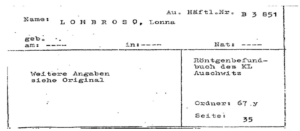
This record, however, states that B3851 was Lazare’s number.
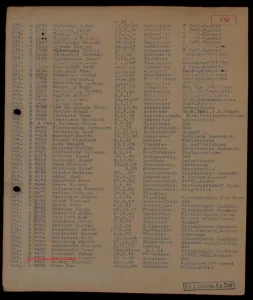
Source: ITC, Bad Arolsen
Lazare’s father, Haïm Lombroso, who was born on May 5, 1884 in Istanbul, had been already deported from the Beaune-la-Rolande camp to Auschwitz on Convoy 36 on September 23, 1942
Repatriation and medical condition
Lazare Lombroso was interned at Drancy on July 15, 1944, assigned prisoner number 25187, and deported to the Auschwitz concentration camp on July 31, 1944.
He was transferred from Auschwitz to Dachau, where he arrived on January 28, 1945, and was assigned the prisoner number 39587. He was liberated from Mittelwald by the Americans, and we also found information saying that he was liberated from the Octztal Kommando by the Allies.
On May 17, 1945, he was repatriated to Sarrebourg.
Details given during his medical examination:
He was born in Lyon on February 27, 1928.
His address was 120 rue Turenne in the 3rd district of Paris.
He was arrested on “racial” grounds
He was liberated on May 1, 1945.
He was 5’5” tall and weighed just 86 pounds!
His general state of health was described as “mediocre”.
Source: Victims of Contemporary Conflicts Archives Division of the French Ministry of Defense Historical Service.
After he was repatriated, he was sent to the Joffre sanatorium at Champrosay, in Draveil, near Paris. This was a public facility for men suffering from severe tuberculosis.
Source Victims of Contemporary Conflicts Archives Division of the French Ministry of Defense Historical Service
People who were deported for political reasons on grounds of their “race” – our key sources
On September 20, 1956, Lazare Lombroso applied to the departmental office of the French National Office for Veterans and Victims of War for the status of political deportee, having been deported on grounds of his “race” (see below).
The application includes his personal details (name, address, occupation, etc.) as well as essential information about the deportation (date on which he was deported, place to where he was deported, etc).
His dossier number is 21 P 565 698. It contains a wide range of documents: a medical record, details of a medical examination, letters, a birth certificate, inspection forms, a deportation form and a deportation certificate, among others
His request was granted, and he is listed in the French register of political deportees.
This application gave us access to various sources for our research.
Source: Victims of Contemporary Conflicts Archives Division of the French Ministry of Defense Historical Service.
The place to which he sent the application is on Rue Bercy in Paris, an area that has changed enormously. Where once we would have seen old signs and buildings, now there are modern ones. The difference is striking.
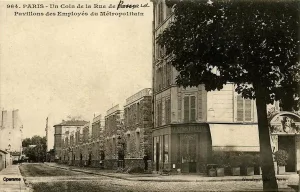
Before (around 1964)

After (2022)
Lastly, among the records we also found a letter referring to a fellow deportee called Elysée Manceaux, but we were unable to find any further details about him.
Sources:
- Source: Victims of Contemporary Conflicts Archives Division of the French Ministry of Defense Historical Service, in Caen.
- Source: The International Tracing Service at Bad Arolsen
- Source: Auschwitz-Birkenau museum archives, Former Prisoners department
- Deposit certificate from the Paris Police Headquarters
Sources provided by the Convoy 77 project team
The ITS and DAVCC sources were provided by Convoy 77. They also suggested that we search the Shoah Memorial website.
Overview of these sources:
The International Tracing Service at Bad Arolson
The International Tracing Service (ITS) is a resource center for records and information on Nazi persecution and the liberation of survivors. It holds more than 30 million records and provides former victims of persecution and their descendants with information on their incarceration and forced labor, as well as about assistance provided by the Allies after the war,.
The students were also provided with a list of research-related websites to add to the sites and information they had found through their own Internet research.
Victims of Contemporary Conflicts Archives Division of the French Ministry of Defense Historical Service, in Caen.
In Caen, on the north coast of France, the Victims of Contemporary Conflicts Archives Division of the Ministry of Defense Historical Service holds files on individuals, whether dead or still alive, who have been recognized as victims of war and/or have been awarded the distinctions “died for France” or “died during deportation”. Personal records relating to prisoners of war and workers who left for Germany are also kept there. These records can be very useful in retracing the history of interned people or their family members, and in finding out about any applications or administrative procedures that were undertaken after the war.
The Shoah Memorial in Paris
In France, the Shoah Memorial takes a similar approach to that of Yad Vashem, by researching the lives of Holocaust victims that were arrested in France, whether or not they survived. In France, the Shoah memorial takes a similar approach to the Yad Vashem center, researching victims of the Shoah arrested in France who have died or survived. Visitors to their website can search a database that includes the Wall of Names list (victims who were deported), the register of Jews killed in France but not deported, the register of Jewish resistance fighters who were members of the Jewish Combat Organization networks, and the register of the Righteous Among the Nations from France, compiled by Yad Vashem. The database has been compiled from various record sets, which may explain some spelling discrepancies in surnames, first names and dates of birth etc. The staff of the National Memorial to the Montluc Prison kindly provided us with any relevant records available to them, and shared some working tools to help us get started.
Links:
- https://michelle-goldstein.blogspot.com/2007/11/des-nouvelles-de-bad-arolsen.html
- https://www.memorialdelashoah.org/
- https://www.nadir.org/nadir/kampagnen/mittenwald/2005/bro/Zweimal-auf-dem-Todesmarsch.html
- https://www.musee-armee.fr/fileadmin/user_upload/Documents/Support-Visite-Fiches-Objets/Fiches-1939-1945/MA_fiche-objet-etoile-jaune.pdf/
- https://www.deportesdelyon.fr/les-archives-par-famille-a-m/enfants-lombroso/
- Map produced by the students as part of the project: https://umap.openstreetmap.fr/fr/map/trajet-de-lazare-lombroso_730665#5/48.822/20.168


 Français
Français Polski
Polski